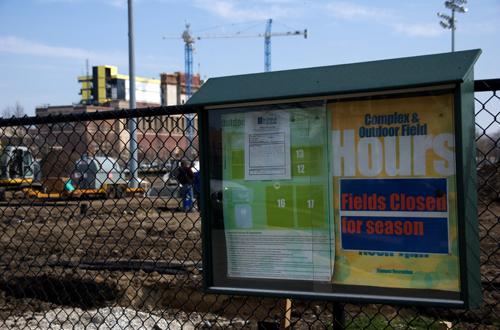Field turf project receives criticism

Apr 24, 2008
Last updated on May 13, 2016 at 10:16 a.m.
Construction on the University intramural fields is scheduled to begin this summer and to be completed in August, but environmental concerns have circulated around the renovations.
The Board of Trustees voted and approved to replace the intramural sports fields, located at Stadium Drive and First Street in Champaign, with artificial turf, which some environmental and public health groups have pegged as harmful.
Chime Asonye, student trustee and senior in LAS, said the board voted on this issue Jan. 17. The artificial turf will be similar to the turf in the Irwin Indoor Practice Facility, Asonye said.
“For the Irwin building, the turf was installed in the fall of 2001,” said Kent Brown, assistant athletics director. “It’s called AstroPlay, and it’s completely infilled with rubber pellets, an industry standard.”
Get The Daily Illini in your inbox!
But AstroPlay has gone out of business since the University did business with them in 2001, Brown said.
The artificial turf will be installed by Cooling Landscape Contractors of Cherry Valley, Ill., Asonye said. The Illinois Board of Higher Education approved this purchase and construction project April 16, he added.
At a recent Illinois Board of Higher Education Student Advisory Committee meeting, state Sen. Michael Frerichs, D-Champaign, and state Rep. Naomi Jakobsson, D-Urbana, discussed completing the turf construction in an environmentally responsible way, Asonye said.
However, the Environment and Human Health, Inc., a nonprofit organization founded in 1997 to protect human health, says on its Web site that artificial turf poses a health risk.
“Synthetic turf materials are made out of plastic and ground up rubber tires – both of which tend to absorb heat and get much hotter than the air around them,” according to the group’s Web site fact sheet.
The organization, which consists of doctors, public health professionals and health and environment policy experts, cites the Connecticut Agricultural Experiment Station Report for health concerns. The report said small amounts of the chemicals found in the rubber infill can leak into the air to cause skin and eye irritations, and metals such as zinc and lead can be released into ground water.
The Connecticut Department of Public Health issued an artificial turf fact sheet in October 2007.
“Based upon the current evidence, a public risk appears unlikely,” according to the public health fact sheet. There is still uncertainty, however, and the department suggested additional investigation is warranted.
But Scott Bretthauer, University Extension specialist for pesticide safety education, said changing to artificial turf has benefits.
“With artificial turf, you wouldn’t have to apply the fertilizers and pesticides that you do to grow the grass,” Bretthauer said.





